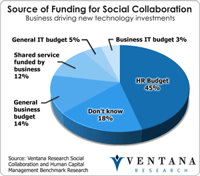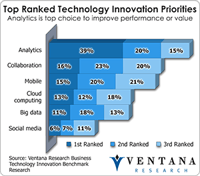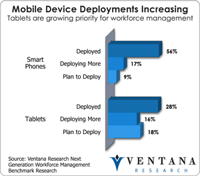The necessity of learning is essential for every organization to realize the full potential of the workforce. But many organizations treat learning like training or academic instruction to ensure policy or compliance to a minimum level of work performance, instead of continuing career education and improving skills in the operational workflow. The context for where and how workers work is critical to ensure that on-the-job learning is possible. While traditional learning management systems...
Read More
Topics:
Human Capital Management,
Learning,
LMS,
Digital Business,
inkling,
LXP
The workforce is the center of any organization, no matter if the workforce consists of employees, contractors or what we call gig workers. It stands to reason that a black-swan event has an immediate impact on a workforce and thus an organization’s overall business health. In challenging times, a “family-first” mentality tends to take hold — a reality that, far too often, business leaders and HR organizations underestimate. But organizational readiness is essential for sustainability and...
Read More
Topics:
Sales,
Human Capital Management,
Learning,
Office of Finance,
Voice of the Customer,
Analytics,
Digital Technology,
Digital Marketing,
Operations & Supply Chain,
Workforce Optimization,
AI & Machine Learning
Maximizing the performance and value of people in the workforce should be a primary focus for any business these days. It is a complex task, especially for larger organizations, and chances for success can be increased by investment in human capital management (HCM) applications. In this competitive software market SAP is making a strong push, aided by acquisitions in the last three years of SuccessFactors for talent management and more recently Fieldglass for contingent labor management....
Read More
Topics:
SAP,
HCM,
Human Capital Management,
Learning,
Performance,
Recruiting,
SuccessFactors,
Operational Performance,
Analytics,
Business Analytics,
Business Performance,
Cloud Computing,
Financial Performance,
Compensation,
HRMS,
Vendor Management Systems,
Workforce Analytics,
Workforce Management,
Workforce Planning
Improving how employees and managers can improve talent management activities through changes in process, technology and better access to information is both a theme of my research agenda this year. It is also what the key technology vendors in this space have been focused on developing products to do. Cornerstone OnDemand is one of those vendors that has been in the talent management space since 1999, when it launched its original CyberU learning management product, and now offers a broad...
Read More
Topics:
Sales Performance,
Salesforce.com,
Social Media,
HCM,
Learning,
Performance,
Recruiting,
Business Collaboration,
Business Performance,
Cloud Computing,
Workforce Performance,
Cornerstone OnDemand,
HR
Read More
Topics:
Sales Performance,
Social Media,
Supply Chain Performance,
Human Capital Management,
Kenexa,
Learning,
Performance,
Recruiting,
Smarter Analytics,
Smarter Workforce,
Social Business,
Social Collaboration,
Operational Performance,
Business Analytics,
Business Collaboration,
Business Intelligence,
Business Performance,
Cloud Computing,
Customer & Contact Center,
Financial Performance,
IBM,
Workforce Performance,
Compensation
Human capital is most organizations’ largest investment and one of their largest differentiators against the competition. So it follows that those that take advantage of the compelling, game-changing technology now available in human capital management (HCM) will place themselves at a competitive advantage.
Read More
Topics:
Big Data,
Social Media,
HCM,
Human Capital Management,
Learning,
Office of Finance,
Social Collaboration,
Analytics,
Business Analytics,
Business Collaboration,
Business Intelligence,
Business Performance,
Cloud Computing,
Information Applications,
Information Management,
Workforce Performance,
CFO,
Compensation,
finance,
HR,
Talent Management,
Workforce Management
Acquisitions and new product releases continue to make the market for human capital management a hotbed of activity, as organizations attempt to fully utilize and increase the value of their workforces as I have outlined in my research agenda. ADP, with more than $10 billion in revenues and more than 570,000 customers, is aiming for the top spot in this market.
Read More
Topics:
Mobile,
Social Media,
HCM,
Human Capital Management,
Learning,
LMS,
Performance,
Operational Performance,
Business Analytics,
Business Performance,
Cloud Computing,
Financial Performance,
Workforce Performance,
Compensation,
HR,
TCM
Investing wisely in sales-related people and processes is a key to business success. In 2012, helping sales staff perform at their highest levels should be a top priority for management. That may take some effort, according to our benchmark research, which indicates that only 14 percent of sales organizations operate at the highest level of innovation and competitiveness. In recent years, most organizations merely discussed moving beyond using only their sales force automation application and...
Read More
Topics:
Big Data,
Mobile,
Planning,
Sales,
Sales Performance,
Social Media,
assets,
Learning,
Office of Finance,
Performance,
Reporting,
Sales Compensation,
Sales Force Automation,
Operational Performance,
Analytics,
Business Analytics,
Business Collaboration,
Business Mobility,
Business Performance,
Cloud Computing,
Collaboration,
Customer & Contact Center,
Financial Performance,
Workforce Performance,
channel,
coaching,
commission,
CRM,
Sales Performance Management,
SFA
Consolidation in the human capital management software market is in full swing. Recently Peopleclick Authoria acquired Aquire Solutions, and just this week Golden Gate Capital and Infor agreed to buy Lawson Software for about $2 billion, which my colleague Robert Kugel commented.
Read More
Topics:
Performance Management,
Sales Performance,
Human Capital Management,
Learning,
Learning Management System,
Operational Performance,
Business Analytics,
Business Collaboration,
Business Mobility,
Business Performance,
Cloud Computing,
Customer & Contact Center,
Financial Performance,
Workforce Performance,
Compensation,
Talent Management,
Workforce Planning
Human resources professionals must deal with volumes of workforce data that resides in disparate software systems, including individual spreadsheets. But although the data is accessible to them, many organizations don’t have technology to aggregate, synthesize and analyze it, and so cannot easily use it to make efficient and effective decisions about talent acquisition and talent management.
Read More
Topics:
Learning,
Performance,
Recruiting,
Operational Performance,
Business Analytics,
Business Mobility,
Business Performance,
Cloud Computing,
Mobility,
Workforce Performance,
Compensation,
Hiring,
Talent Management,
Workforce Analytics
















